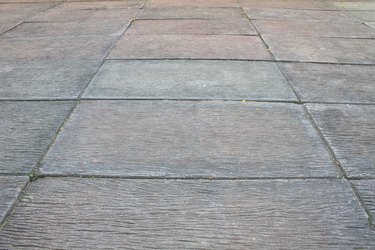
Concrete is an optimal material for sidewalks, patios and driveways, but any time you pour a slab, it is destined to crack. Freeze/thaw cycles and soil movement virtually guarantee that any slab wider than a few feet will eventually develop some fissures. Cutting a concrete slab will not prevent cracking -- the purpose of cutting is to encourage cracking in "control joints," where cracking won't visibly detract from the surface of the slab. Cutting concrete all the way through, meanwhile, is a bigger job, made harder the older the concrete is.
Cutting Depth
Video of the Day
Your local building authority might have a regulation controlling joint depth, but if not, a standard rule of thumb is to cut to a depth that is at least one-quarter of the slab's thickness. For a standard 4-inch-thick slab, that would be a 1-inch-deep cut. The deeper the cut the more likely the slab is to crack in the control joint -- but you can't cut so deeply that you run into the steel reinforcement in the middle of the slab.
Video of the Day
Grooving the Cuts
For relatively small or narrow slabs, groove the control joints after the concrete sets but before it completely hardens. Groove by hand with a concrete grooving tool whose attached blade slices through the semisolid concrete. For a straight and uniform cut, pop a chalk line on the slab before grooving, or position a two-by-four on the slab as a guide. Hand-grooving works well on sidewalks and similar small pours.
Sawing the Cuts
If you miss the short window of time while the concrete is still soft enough to hand-groove, you will have to make the cuts with a saw. The best time to saw the slab is after the concrete has cured enough that you can safely walk on it but before it is completely dry. It should still look damp and slightly dark. Depending on the humidity and the consistency of the concrete when you poured, this could take six to 24 hours after the pour. For small slabs, use a heavy-duty circular saw fitted with a diamond or masonry blade. If the slab is larger, such as a driveway, rent a walk-behind concrete saw to save your knees.
Joint Placement
Local building codes sometimes prescribe a minimum distance between control joints. If they do not apply in your municipality, a couple of construction industry guidelines can help. For sidewalks, the general rule is to space cuts as far apart as the width of the walk. A 3-foot sidewalk should be cut crosswise every 3 feet. For larger slabs, a general rule is to take the slab thickness in inches and double that number in feet to determine joint placement. For example, if you have a 4-inch-thick slab, double the number 4: Cut a control joint every 8 feet or less. For a 5-inch slab, control joint maximum distance would be 10 feet. You can play with the measurements slightly to get the best visual effect, but don't stray too far from the standard.
Cutting Through Concrete
When plumbing fails beneath a slab-on-grade foundation, cutting away the existing floor to make repairs is necessary. Slab foundations can be much thicker than patio and sidewalk slabs, requiring the use of commercial concrete saws and industrial-grade saw blades. In an indoor situation, walk-behind concrete wet saws, which reduce airborne concrete dust, are available for rent from construction rental stores. Cutting through a concrete slab is a noisy, dusty, messy project that requires the use of protective eyewear and a respirator mask.